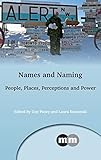Names and Naming : People, Places, Perceptions and Power / ed. by Guy Puzey, Laura Kostanski.
Material type: TextSeries: Multilingual MattersPublisher: Bristol ; Blue Ridge Summit : Multilingual Matters, [2016]Copyright date: ©2016Description: 1 online resourceContent type:
TextSeries: Multilingual MattersPublisher: Bristol ; Blue Ridge Summit : Multilingual Matters, [2016]Copyright date: ©2016Description: 1 online resourceContent type: - 9781783094912
- 9781783094929
- 910/.014
- P325.5.O55 N36 2016
- P325.5.O55
- online - DeGruyter
- Issued also in print.
| Item type | Current library | Call number | URL | Status | Notes | Barcode | |
|---|---|---|---|---|---|---|---|
 eBook
eBook
|
Biblioteca "Angelicum" Pont. Univ. S.Tommaso d'Aquino Nuvola online | online - DeGruyter (Browse shelf(Opens below)) | Online access | Not for loan (Accesso limitato) | Accesso per gli utenti autorizzati / Access for authorized users | (dgr)9781783094929 |
Frontmatter -- Contents -- Contributors -- Acknowledgements -- Trends in Onomastics: An Introduction -- Part 1: The Varied Identities of People and Places -- 1. Internet Personal Naming Practices and Trends in Scholarly Approaches -- 2. Visitor Experiences of Aboriginal Place Names in Colonial Victoria, Australia, 1834-1900 -- 3. Introduced Personal Names for Australian Aborigines: Adaptations to an Exotic Anthroponymy -- 4. Personal Naming and Community Practices in the Western Isles of Scotland: Putting Names in the 'Gaelic Sense' -- 5. Signs of/on Power, Power on/of Signs: Language-Based Tourism, Linguistic Landscapes and Onomastics on Norfolk Island -- Part 2: Attitudes and Attachment -- 6. The Controversy of Restoring Indigenous Names: Lessons Learnt and Strategies for Success -- 7. Attitudes to Street Names in Helsinki -- 8. Linguistic Landscape and Inhabitants' Attitudes to Place Names in Multicultural Oslo -- 9. Attitudes to Scots: Insights from the Toponymicon -- 10. Slang Toponyms in Hungary: A Survey of Attitudes Among Language Users -- Part 3: Power, Resistance and Control -- 11. Renaming as Counter-Hegemony: The Cases of Noreg and Padania -- 12. Naming Parks, Footpaths and Small Bridges in a Multicultural Suburban Area -- 13. Personal Names in Language Policy and Planning: Who Plans What Names, for Whom and How? -- 14. Is the Official Use of Names in Norway Determined by the Place- Names Act or by Attitudes? -- 15. The Power of Administration in the Official Recognition of Indigenous Place Names in the Nordic Countries -- Index
restricted access online access with authorization star
http://purl.org/coar/access_right/c_16ec
This book explores international trends in naming and contributes to the growing field of onomastic enquiry. Naming practices are viewed here through a critical lens, demonstrating a high level of political and social engagement in relation to how we name people and places. The contributors to this publication examine why names are not only symbols of a person or place, but also manifestations of cultural, linguistic and social heritage in their own right. Presenting analyses of geographically and culturally diverse perspectives and case studies, the book investigates how names can represent deeper kinds of identity, act as objects of attachment and dependence, and reflect community mores and social customs while functioning as powerful mechanisms of inclusion and exclusion. The book will be of interest to researchers in onomastics, sociology, human geography, linguistics and history.
Issued also in print.
Mode of access: Internet via World Wide Web.
In English.
Description based on online resource; title from PDF title page (publisher's Web site, viewed 24. Apr 2022)


